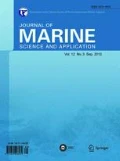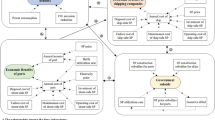Abstract
The integration of wave energy converters (WECs) with floating breakwaters has become common recently due to the benefits of both cost-sharing and providing offshore power supply. In this study, based on viscous computational fluid dynamics (CFD) theory, we investigated the hydrodynamic performances of the floating box and Berkeley Wedge breakwaters, both of which can also serve as WECs. A numerical wave flume model is constructed using Star-CCM+ software and applied to investigate the interaction between waves and wave energy converters while completing the verification of the convergence study of time and space steps. The effects of wave length on motion response and transmission coefficient of the floating box breakwater model are studied. Comparisons of our numerical results and published experimental data indicate that Star-CCM+ is very capable of accurately modeling the nonlinear wave interaction of floating structures, while the analytical potential theory overrates the results especially around the resonant frequency. Optimal damping can be readily predicted using potential flow theory and can then be verified by CFD numerical results. Next, we investigated the relationship between wave frequencies and various coefficients using the CFD model under optimal damping, including the motion response, transmission coefficient, reflection coefficient, dissipation coefficient, and wave energy conversion efficiency. We then compared the power generation efficiencies and wave dissipation performances of the floating box and Berkeley Wedge breakwaters. The results show that the power generation efficiency of the Berkeley Wedge breakwater is always much higher than that of the floating box breakwater. Besides, the wave dissipation performance of the Berkeley Wedge breakwater is much better than that of the floating box breakwater at lower frequency.







Similar content being viewed by others
References
Arena F, Romolo A, Malara G, Ascanelli A (2013) On design and building of a U-OWC wave energy converter in the mediterranean sea: a case study. In: Proceedings of the 32nd International Conference on Ocean, Offshore and Arctic Engineering. Nantes. https://doi.org/10.1115/OMAE2013-11593
Boccotti P (2007) Comparison between a U-OWC and a conventional OWC. Ocean Eng 34(5):799–805. https://doi.org/10.1016/j.oceaneng.2006.04.005
Budar K, Falnes J (1975) A resonant point absorber of ocean-wave power. Nature 256(5517):478–479. https://doi.org/10.1038/256478a0
Chen Q, Zang J (2018) Numerical study of the hydrodynamic performance of a pile-restrained WEC-type floating breakwater. The 33rd International Workshop on Water Waves and Floating Bodies. http://iwwwfb2018.ensta-bretagne.fr. Accessed 20 May 2017
Chen ZF, Zhou BZ, Zhang L, Li C, Zang J, Zheng XB, Xu JA, Zhang WC (2018a) Experimental and numerical study on a novel dual-resonance wave energy converter with a built-in power take-off system. Energy 165:1008–1020. https://doi.org/10.1016/j.energy.2018.09.094
Chen ZF, Zhou BZ, Zhang L, Sun L, Zhang XW (2018b) Performance evaluation of a dual resonance wave-energy convertor in irregular waves. Appl Ocean Res 77:78–88. https://doi.org/10.1016/j.apor.2018.04.014
Chow YC, Chang YC, Chen DW, Lin CC, Tzang SY (2018) Parametric design methodology for maximizing energy capture of a bottom-hinged flap-type WEC with medium wave resources. Renew Energy 126:605–616. https://doi.org/10.1016/j.renene.2018.03.059
Cruz J (2007) Ocean wave energy: current status and future prespectives. Springer. http://refhub.elsevier.com/S0960-1481(16)30359-7/sref9. Accessed 24 May 2017
Diamantoulaki I, Angelides DC, Manolis GD (2008) Performance of pile-restrained flexible floating breakwaters. Appl Ocean Res 30(4):243–255. https://doi.org/10.1016/j.apor.2009.03.004
Fenton JD (1988) The numerical solution of steady water wave problems. Comput Geosci 14:357–368. https://doi.org/10.1016/0098-3004(88)90066-0
Falcão AFO (2010) Wave energy utilization: a review of the technologies. Renew Sust Energ Rev 14:899–918. https://doi.org/10.1016/j.rser.2009.11.003
He F, Huang Z, Law AWK (2013) An experimental study of a floating breakwater with asymmetric pneumatic chambers for wave energy extraction. Appl Energy 106:222–231. https://doi.org/10.1016/j.apenergy.2013.01.013
He F, Huang Z (2014) Hydrodynamic performance of pile-supported OWC-type structures as breakwaters: an experimental study. Ocean Eng 88:618–626. https://doi.org/10.1016/j.oceaneng.2014.04.023
Isaacson M, Baldwin J, Bhat S (1998) Wave propagation past a pile-restrained floating breakwater. Int J Offshore Polar Eng 8(4):265–269. https://www.onepetro.org/journal-paper/ISOPE-98-08-4-265. Accessed 14 February 2017
Madhi F, Meghan ES, Ronald WY (2013) The “Berkeley Wedge”: an asymmetrical energy-capturing floating breakwater of high performance. Mar Syst Ocean Technol 1:5–16. https://scinapse.io/papers/2189354237. Accessed 11 May 2017
McCartney BL (1985) Floating breakwater design. J Waterw Port Coast Ocean Eng 111(2):304–318. https://doi.org/10.1061/(ASCE)0733-950X(1985)111:2(304)
Mendonça A, Dias J, Didier E, Fortes CJEM, Neves MG, Reis MT, Conde JMP, Poseiro P, Teixeira PRF (2018) An integrated tool for modelling oscillating water column (OWC) wave energy converters (WEC) in vertical breakwaters. J Hydro Environ Res 19:198–213. https://doi.org/10.1016/j.jher.2017.10.007
Michailides C, Angelides DC (2012) Modeling of energy extraction and behavior of a flexible floating breakwater. Appl Ocean Res 35:77–94. https://doi.org/10.1016/j.apor.2011.11.004
Ning DZ, Zhao XL, Göteman M, Kang HG (2016) Hydro- dynamic performance of a pile-restrained WEC-type floating breakwater: an experimental study. Renew Energy 95:531–541. https://doi.org/10.1016/j.renene.2016.04.057
Ning DZ, Zhao XL, Hann M, Kang HG (2017) Analytical investigation of hydrodynamic performance of a dual pontoon WEC-type breakwater. Appl Ocean Res 65:102–111. https://doi.org/10.1016/j.apor.2017.03.012
Perez-Collazo C, Greaves D, Iglesias G (2018) Hydrodynamic response of the WEC sub-system of a novel hybrid wind-wave energy converter. Energy Convers Manag 171:307–325. https://doi.org/10.1016/j.enconman.2018.05.090
Takahashi S, Nakada H, Ohneda H, Shikamori M (1992) Wave power conversion by a prototype wave power extracting caisson in Sakata port. In: Proc. of 23rd International Conference on Coastal Engineering, ASCE, New York, 3440–3453. http://refhub.elsevier.com/S0960-1481(16)30359-7/sref37. Accessed 18 Jan 2017
You YG, Zheng YH, Shen YM, Wu BJ, Liu R (2003) Wave energy study in China: advancements and perspectives. China Ocean Eng 17:101–109. https://doi.org/10.3321/j.issn:0890-5487.2003.01.010
Zanuttigh B, Martinelli L, Castagnetti M, Ruol P, Kofoed JP, Frigaard P (2010) Integration of wave energy converters into coastal protection schemes. In: Proceedings of the 3rd International Conference on Ocean Energy (ICOE), Bilbao. http://refhub.elsevier.com/S0960-1481(16)30359-7/sref42. Accessed 10 Feb 2017
Zhao XT, Yang JM (2015) Power capture performance of an oscillating-body WEC with nonlinear snap through PTO systems in irregular waves. Appl Ocean Res 52:261–273. https://doi.org/10.1016/j.apor.2015.06.012
Zhao XL, Ning DZ, Zhang CW, Kang HG (2017) Hydrodynamic investigation of an oscillating buoy wave energy converter integrated into a pile-restrained floating breakwater. Energies 10(5):712. https://doi.org/10.3390/en10050712
Zhou BZ, Ning DZ, Teng B, Bai W (2013) Numerical investigation of wave radiation by a vertical cylinder using a fully nonlinear HOBEM. Ocean Eng 70: 1-13. https://doi.org/10.1016/j.oceaneng.2013.04.019
Zhou BZ, Wu L, Xu GD, Zhang L (2017) Resonance of the roll motion of a two dimensional barge induced by triple frequency wave force. Ocean Eng 134:13–23. https://doi.org/10.1016/j.oceaneng.2017.02.012
Acknowledgements
The authors gratefully acknowledge the financial support from the Lloyd’s Register Foundation (LRF) through the joint center involving University College London, Shanghai Jiaotong University, and Harbin Engineering University. The LRF helps to protect life and property by supporting engineering-related education, public engagement, and the application of research.
Funding
This research was financially supported by the National Natural Science Foundation of China (51409066, 51761135013), High Technology Ship Scientific Research Project from the Ministry of Industry and Information Technology of the People’s Republic of China–Floating Security Platform Project (the second stage, 201622), and the Fundamental Research Fund for the Central University (HEUCF180104, HEUCFP201809).
Author information
Authors and Affiliations
Corresponding author
Additional information
Article Highlights
• Integrating floating breakwaters with WECs has the benefits of both cost-sharing and providing offshore power supply.
• The wave energy absorption ability of the Berkeley Wedge breakwater is much better than that of the floating box breakwater.
• The wave dissipation performance of the Berkeley Wedge breakwater is better than that of the floating box breakwater at lower frequency.
Rights and permissions
About this article
Cite this article
Zhang, H., Ding, X., Zhou, B. et al. Hydrodynamic Performance Study of Wave Energy–Type Floating Breakwaters. J. Marine. Sci. Appl. 18, 64–71 (2019). https://doi.org/10.1007/s11804-019-00064-y
Received:
Accepted:
Published:
Issue Date:
DOI: https://doi.org/10.1007/s11804-019-00064-y




